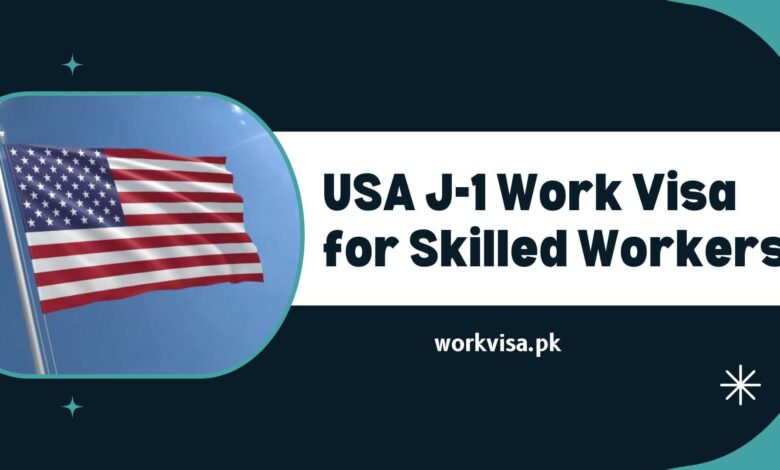USA J-1 Work Visa for Skilled Workers 2025 – Apply Now

If you are a skilled international worker who is contemplating opportunities in the United States, the recently updated Exchange Visitor Skills List provides a new perspective on how the United States views your field of expertise and its alignment with global development objectives. Participants in the J-1 Exchange Visitor Program, particularly those who are seeking to advance their professions while making a positive impact on their native countries, are directly impacted by these changes.
Here is a method by which you can comprehend and capitalize on these modifications.
Check Also: High Demand Work Visa Jobs in Luxembourg
What Is the Exchange Visitor Skills List? (If You Don’t Know)
The Skills List delineates the areas of expertise that are essential for the advancement of specific nations. You may be required to return to your home country for a minimum of two years before applying for specific U.S. visas (such as H-1B) or permanent residency if your country is specified and you are enrolled in a J-1 program that is in accordance with these fields.
Nevertheless, the most recent revisions have resulted in modifications to the economic criteria and countries, which may present opportunities for competent workers to circumvent this requirement or more effectively align their career objectives.
2 Major Key Changes to U.S. Exchange Visitor Skills List Announced
The United States Department has announced the following two significant changes:
1# Updated Country Designations:
The U.S. Department of State has altered the process by which countries are assessed for inclusion on the Skills List. The assessment is performed using three criteria:
- Economic Growth: Countries with a per capita GDP below $7,500 are deemed to require skill development. These nations are prioritized to guarantee that their citizens acquire specialized knowledge and contribute to the development of their country.
- Small countries with restricted resources: This category also encompasses nations with GDPs ranging from $7,500 to $15,000, but who are grappling with developmental obstacles, such as the inability to establish specialized skill based centers. This guarantees that minor nations are not excluded from the development of a competent workforce.
- Migration Trends: Countries that are experiencing a substantial outflow of skilled migrants are prioritized. This encourages highly trained individuals to return and support their native country, thereby reversing the effects of “brain drain” and retaining talent.
What this means for you?
You may no longer be subject to the two-year home residency requirement after completing a J-1 program if your country’s economic conditions or migration trends have improved. This implies a larger degree of adaptability in pursuing additional opportunities in the United States. Aligning your career with high-priority skills can help you stand out in your field and contribute to national development if your country is still listed.
2# No Change in Skills
The Skills List continues to necessitate the same skills as the 2009 version. These consist of:
- Medical Care: Medicine, nursing, public health, and clinical sciences continue to be highly regarded. Training in these disciplines offers the potential to resolve health challenges in developing countries and have a global impact.
- Engineering: Civil, mechanical, environmental, and software engineering are critical for the advancement of technology and infrastructure, both domestically and internationally.
- Information Technology and Technology: Artificial intelligence, cybersecurity, robotics, and database administration are essential for addressing contemporary challenges and fostering innovation.
- Education: The development of future generations of competent professionals is contingent upon the roles of STEM education, curriculum design, and early childhood development.
- Areas of Creativity: Professionals have the opportunity to contribute to the cultural and economic enrichment of society through opportunities in the fields of visual arts, animation, performing arts, and graphic design.
What this means for you?
Your abilities are in high demand on a global scale if you specialize in any of these disciplines. Maximizing the value of your J-1 exchange program and establishing yourself as a leader in your industry can be achieved by aligning with these areas. This can result in thrilling career opportunities and allow you to make a significant contribution to the advancement of your native country.
Benefits of USA J-1 Work Visa for Skilled Workers
- Opportunities for Professional Development: The J-1 visa enables experienced workers to acquire practical experience in their respective fields, thereby improving their career prospects and expertise.
- Cultural Exchange: The program fosters cultural exchange by providing participants with the chance to fully engage with American culture while simultaneously sharing their own traditions and perspectives.
- Opportunities for Networking: J-1 visa holders have the opportunity to establish connections with industry professionals, thereby establishing valuable networks for future career opportunities.
- Length of Stay: Skilled laborers are permitted to remain in the United States for a maximum of 18 months (trainees) or 12 months (interns), with the possibility of extensions contingent upon the program.
- Dependents Are Allowed to Participate: J-1 visa holders are permitted to bring their spouse and children (under the J-2 visa category) to the program, thereby enabling families to remain together.
- Work Authorization for Dependents: The J-2 visa holder’s spouses have the option to file for work authorization, which would allow them to lawfully work in the United States during the J-1 visa holder’s stay.
- Exposure to International Practices: Participants’ marketability and skill set are improved as a result of their exposure to global work practices, standards, and technologies.
- Training Programs That Are Structured: It is mandatory for employers to implement structured training programs in order to guarantee that participants acquire pertinent and valuable experience under the J-1 visa.
- Access to Facilities of the Highest Quality: J-1 visa holders frequently obtain employment opportunities at educational facilities, research institutions, or prominent organizations, where they can capitalize on state-of-the-art resources and expertise.
- Career Advancement Pathway: J-1 visa experience enhances resumes and provides access to prospective career opportunities in the United States or abroad.
References
- https://www.federalregister.gov/documents/2024/12/09/2024-28718/public-notice-of-revised-exchange-visitor-skills-list
- https://travel.state.gov/content/travel/en/us-visas/study/exchange/waiver-of-the-exchange-visitor/exchange-visitor-skills-list.html.
Frequently Asked Questions:
-
Who qualifies for a J-1 visa?
Under this program, high school students are able to travel to the US and study at a public or private high school while staying with a host family or at a boarding school. By the first day of school, participants must be 15–18.5 years old.
-
How hard is it to get a J-1 visa?
The approval process for J-1 visas is also relatively straightforward. The length of stay depends on the type of activity. Those pursuing academic study may get a visa for up to three years, while camp counselors will typically only get a 3-month stay. Extensions are also variable, depending on the category of visa.
-
Can I work with a J-1 visa in the USA?
Exchange visitors may work in the United States if the work is part of the participants’ approved program (for example, J-1 teachers, professors, summer camp counselors, summer work travel, and au pairs) or when the official program sponsor approves their employment (for example, J-1 students).




